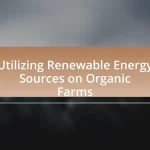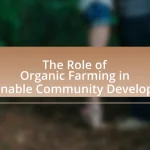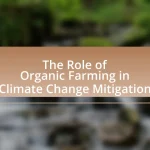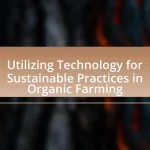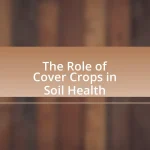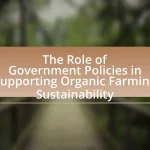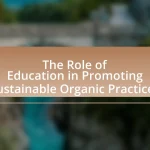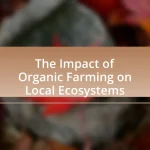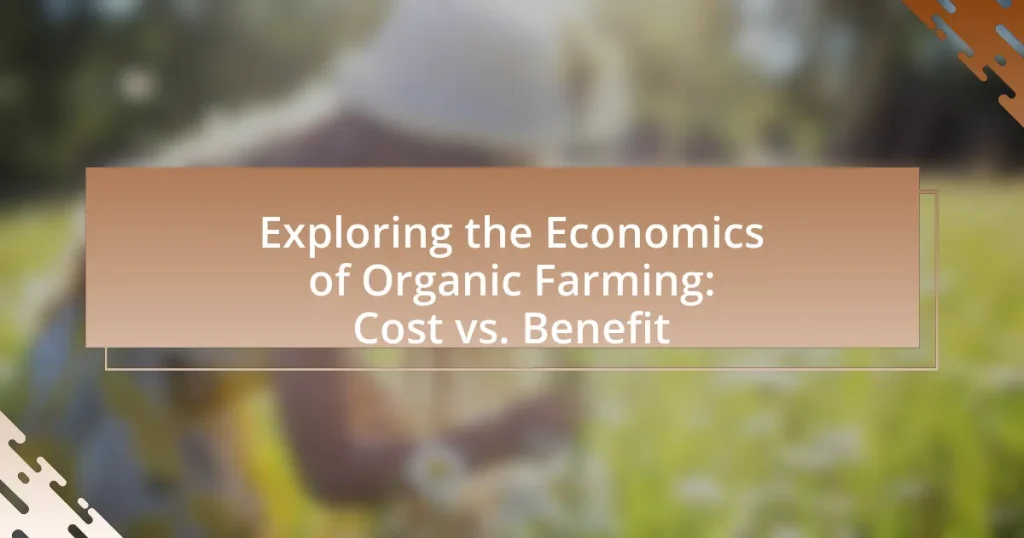The article examines the economics of organic farming, focusing on the cost structures, market demand, pricing strategies, and sustainability associated with this agricultural practice. It highlights the higher initial and ongoing costs of organic farming compared to conventional methods, while also emphasizing the benefits such as premium pricing, improved soil health, and environmental sustainability. Key economic principles, including supply and demand dynamics, government policies, and consumer trends driving organic product demand, are discussed. Additionally, the article addresses the challenges organic farmers face, including market access and production risks, and outlines best practices to enhance profitability and community support’s role in the success of organic farms.
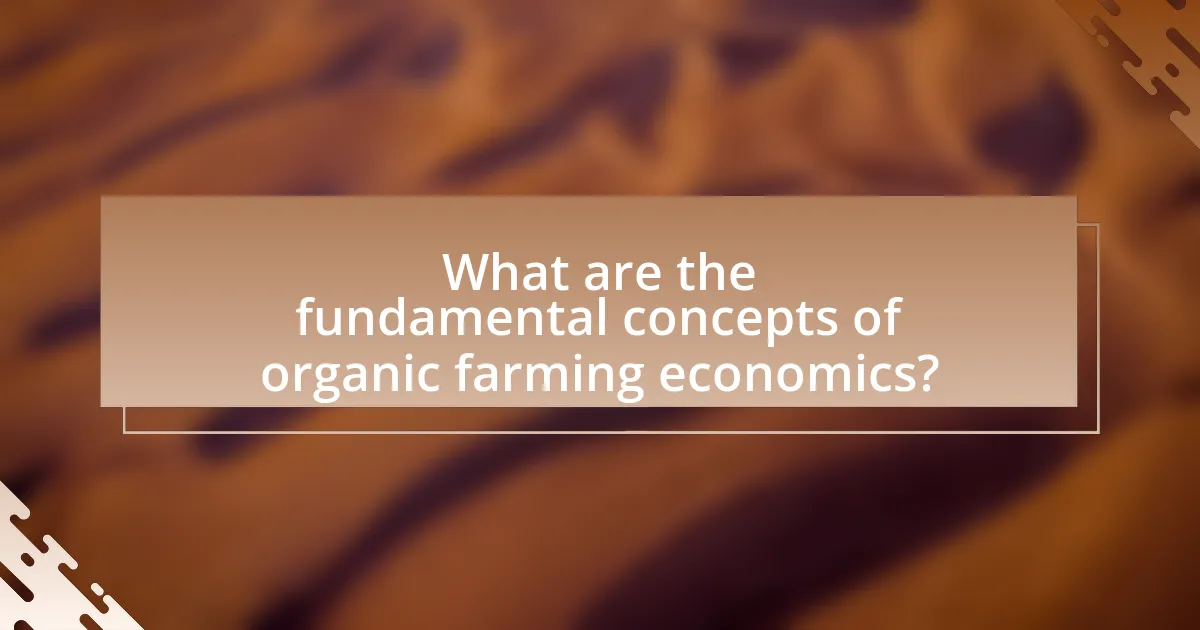
What are the fundamental concepts of organic farming economics?
The fundamental concepts of organic farming economics include cost structures, market demand, pricing strategies, and sustainability. Cost structures in organic farming often involve higher initial investments due to organic certification, labor-intensive practices, and the use of organic inputs, which can lead to increased production costs compared to conventional farming. Market demand for organic products has been rising, with the organic food market valued at approximately $55 billion in the United States in 2020, indicating a strong consumer preference for organic goods. Pricing strategies in organic farming typically reflect the premium consumers are willing to pay for organic products, which can result in higher profit margins. Additionally, sustainability plays a crucial role, as organic farming practices aim to enhance environmental health and biodiversity, which can lead to long-term economic benefits through ecosystem services.
How do costs and benefits compare in organic farming?
Costs in organic farming are generally higher than in conventional farming due to factors such as increased labor, certification fees, and lower yields. However, the benefits include premium prices for organic products, improved soil health, and environmental sustainability. For instance, a study by the USDA found that organic crops can sell for 20-50% more than their conventional counterparts, which can offset the higher production costs. Additionally, organic farming practices contribute to biodiversity and reduce chemical runoff, providing long-term ecological benefits.
What are the initial costs associated with starting an organic farm?
The initial costs associated with starting an organic farm typically range from $10,000 to $50,000, depending on the scale and location of the farm. These costs include land acquisition or leasing, soil testing, organic seeds, equipment, and infrastructure such as irrigation systems and storage facilities. For instance, according to the USDA, organic certification can also incur fees ranging from $500 to $2,000, which adds to the overall startup expenses. Additionally, labor costs for planting and maintaining crops must be considered, as well as potential costs for organic pest control and fertilizers.
What ongoing expenses should organic farmers anticipate?
Organic farmers should anticipate ongoing expenses such as seeds, organic fertilizers, pest management, labor, equipment maintenance, and certification fees. Seeds for organic crops often cost more than conventional seeds, and organic fertilizers are necessary to maintain soil health, contributing to higher costs. Pest management in organic farming typically requires more labor-intensive methods, which increases labor costs. Additionally, equipment maintenance is essential for ensuring operational efficiency, and regular upkeep can be costly. Certification fees for organic farming can also add a significant expense, as farmers must comply with regulations to maintain their organic status. These expenses are critical for sustaining organic farming practices and ensuring compliance with organic standards.
What economic principles underpin organic farming?
Organic farming is underpinned by several economic principles, including sustainability, market demand, and cost-benefit analysis. Sustainability emphasizes long-term ecological balance, which can lead to reduced costs over time through improved soil health and biodiversity. Market demand for organic products has been rising, with the organic food market valued at over $50 billion in the United States in 2021, indicating a willingness to pay premium prices. Cost-benefit analysis in organic farming often reveals higher initial costs due to organic certification and practices, but these can be offset by higher market prices and lower input costs in the long run.
How does supply and demand affect organic farming profitability?
Supply and demand significantly influence organic farming profitability by determining market prices and consumer purchasing behavior. When demand for organic products exceeds supply, prices typically rise, leading to increased profitability for organic farmers. For instance, a report from the Organic Trade Association indicated that organic food sales reached $62 billion in 2020, reflecting a growing consumer preference for organic products. Conversely, if supply outpaces demand, prices may drop, negatively impacting profitability. The balance between supply and demand thus directly affects the financial viability of organic farming operations.
What role do subsidies and government policies play in organic farming economics?
Subsidies and government policies significantly influence organic farming economics by providing financial support and regulatory frameworks that enhance the viability of organic practices. These subsidies can lower production costs for farmers, making organic farming more competitive with conventional agriculture. For instance, the USDA’s Organic Certification Cost Share Program helps offset the costs of organic certification, which can be a barrier for new organic farmers. Additionally, government policies that promote sustainable practices, such as the Farm Bill in the United States, allocate funds specifically for organic research and development, further supporting the growth of the organic sector. This financial backing and regulatory support create a more favorable economic environment for organic farmers, encouraging the adoption of organic methods and contributing to the overall growth of the organic market.

What are the specific benefits of organic farming?
Organic farming offers several specific benefits, including improved soil health, reduced chemical usage, and enhanced biodiversity. Improved soil health results from practices such as crop rotation and composting, which increase organic matter and nutrient availability. Reduced chemical usage minimizes the risk of pesticide and herbicide exposure to humans and wildlife, leading to a safer ecosystem. Enhanced biodiversity occurs as organic farms often support a wider variety of plants and animals, contributing to ecological balance. According to the Rodale Institute, organic farming can sequester carbon in the soil, helping mitigate climate change effects.
How does organic farming impact environmental sustainability?
Organic farming positively impacts environmental sustainability by promoting biodiversity, reducing chemical inputs, and enhancing soil health. This farming method encourages diverse ecosystems, which can lead to increased resilience against pests and diseases. For instance, organic farms often utilize crop rotation and polyculture, practices that support a variety of species and improve soil structure. Additionally, organic farming minimizes the use of synthetic fertilizers and pesticides, which can contaminate water sources and harm wildlife. According to a study published in the journal “Nature,” organic farming can reduce greenhouse gas emissions by up to 40% compared to conventional methods, highlighting its role in mitigating climate change. Furthermore, organic practices enhance soil organic matter, which improves water retention and reduces erosion, contributing to long-term agricultural sustainability.
What are the long-term ecological benefits of organic practices?
Organic practices provide long-term ecological benefits such as enhanced soil health, increased biodiversity, and improved water quality. These practices promote the use of natural fertilizers and pest control methods, which reduce chemical runoff and soil degradation. Research indicates that organic farming can increase soil organic matter by 20-30% over time, leading to better water retention and reduced erosion. Additionally, organic farms support a wider variety of plant and animal species, contributing to ecosystem resilience. Studies show that organic farming systems can reduce greenhouse gas emissions by up to 40% compared to conventional methods, further supporting climate stability.
How does organic farming contribute to biodiversity?
Organic farming contributes to biodiversity by promoting a diverse ecosystem through practices that enhance soil health, reduce chemical inputs, and encourage a variety of plant and animal species. This farming method utilizes crop rotation, cover cropping, and organic fertilizers, which improve soil structure and fertility, leading to a more resilient agricultural system. Research indicates that organic farms typically host 30% more species of plants and animals compared to conventional farms, as shown in a study published in the journal “Nature” by Benis et al. (2017). This increase in biodiversity not only supports ecosystem services such as pollination and pest control but also contributes to the overall sustainability of agricultural practices.
What health benefits are associated with organic farming?
Organic farming is associated with several health benefits, including reduced exposure to harmful pesticides and higher nutritional value in produce. Studies indicate that organic fruits and vegetables contain higher levels of antioxidants and essential nutrients, which contribute to better overall health. For instance, a meta-analysis published in the British Journal of Nutrition found that organic crops have significantly higher antioxidant content compared to conventional crops, which can enhance health outcomes by reducing the risk of chronic diseases. Additionally, organic farming practices promote biodiversity and healthier ecosystems, which can lead to improved food quality and safety for consumers.
How do organic products compare to conventional products in terms of health?
Organic products generally offer health benefits over conventional products, primarily due to lower pesticide residues and higher nutrient content. Studies indicate that organic produce contains fewer synthetic chemicals, which can reduce exposure to harmful substances. For instance, a meta-analysis published in the British Journal of Nutrition found that organic crops have higher antioxidant levels, which are beneficial for health. Additionally, organic farming practices promote biodiversity and soil health, contributing to a more sustainable food system.
What consumer trends are driving demand for organic products?
Consumer trends driving demand for organic products include increased health consciousness, environmental awareness, and a preference for sustainable practices. Health-conscious consumers are seeking organic products due to perceived benefits such as reduced pesticide exposure and higher nutritional value. According to a 2021 survey by the Organic Trade Association, 77% of consumers believe organic food is healthier than conventional options. Additionally, environmental awareness has surged, with consumers increasingly valuing organic farming’s role in promoting biodiversity and reducing chemical runoff. A Nielsen report from 2020 indicated that 66% of global consumers are willing to pay more for sustainable brands. Lastly, the rise of ethical consumerism has led to a preference for products that align with personal values, further driving the demand for organic goods.
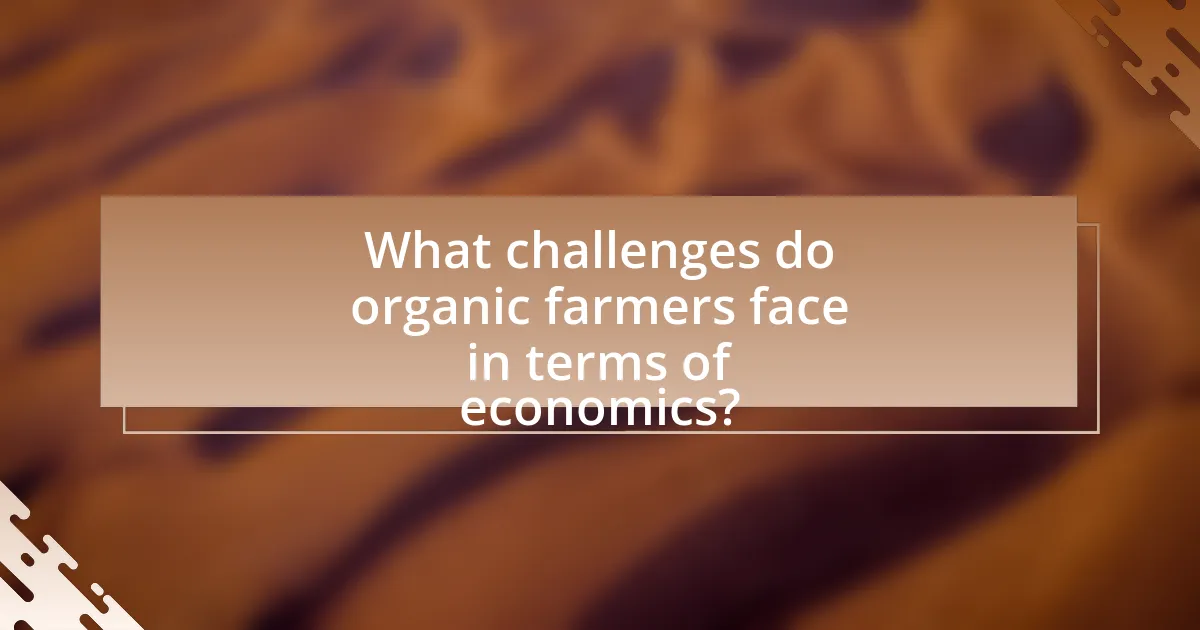
What challenges do organic farmers face in terms of economics?
Organic farmers face significant economic challenges, primarily due to higher production costs and market competition. The costs associated with organic farming, such as organic seeds, natural fertilizers, and pest control methods, are often substantially higher than those for conventional farming. For instance, a study by the USDA found that organic production costs can be 20-50% higher than conventional methods. Additionally, organic farmers frequently encounter challenges in accessing markets, as they compete with lower-priced conventional products, which can limit their profitability. Furthermore, the transition period from conventional to organic farming can take several years, during which farmers may experience reduced yields and income, exacerbating their economic difficulties.
How do market access and distribution affect organic farming profitability?
Market access and distribution significantly influence organic farming profitability by determining the ability of farmers to reach consumers and sell their products at competitive prices. Effective market access allows organic farmers to tap into premium markets, where consumers are willing to pay higher prices for organic products, thus enhancing profit margins. For instance, a study by the USDA found that organic produce can command prices up to 50% higher than conventional counterparts, directly impacting profitability. Additionally, efficient distribution channels reduce costs and improve product freshness, further contributing to higher sales and customer satisfaction. Therefore, the interplay of market access and distribution is crucial for maximizing the financial success of organic farming.
What barriers exist for organic farmers in reaching consumers?
Organic farmers face several barriers in reaching consumers, primarily including limited access to distribution channels, higher marketing costs, and consumer misconceptions about organic products. Limited access to distribution channels restricts organic farmers from effectively getting their products into retail outlets and markets, as many traditional distributors may not prioritize organic goods. Higher marketing costs arise from the need for organic farmers to invest in branding and consumer education to differentiate their products in a competitive market. Additionally, consumer misconceptions, such as the belief that organic products are not significantly different from conventional ones, can hinder purchasing decisions. These barriers collectively impact the ability of organic farmers to connect with and sell to consumers effectively.
How can organic farmers improve their market presence?
Organic farmers can improve their market presence by leveraging direct-to-consumer sales channels, such as farmers’ markets and community-supported agriculture (CSA) programs. These channels allow farmers to establish personal connections with consumers, enhancing brand loyalty and trust. According to a study by the USDA, direct marketing can lead to higher profit margins, as farmers retain a larger share of the retail price compared to traditional distribution methods. Additionally, utilizing social media and online platforms for marketing can significantly increase visibility and reach, allowing organic farmers to engage with a broader audience and showcase their products effectively.
What are the risks associated with organic farming?
The risks associated with organic farming include lower yields, pest and disease challenges, and market fluctuations. Organic farming often results in reduced crop yields compared to conventional methods due to restrictions on synthetic fertilizers and pesticides, which can lead to increased vulnerability to pests and diseases. For instance, a study published in the journal “Agricultural Systems” found that organic farms can yield 20-30% less than conventional farms under similar conditions. Additionally, organic farmers face market risks, as prices for organic products can be volatile and dependent on consumer demand, which can fluctuate significantly. These factors contribute to the economic challenges that organic farmers may encounter.
How do crop failures and pests impact organic farming economics?
Crop failures and pests significantly impact organic farming economics by reducing yields and increasing production costs. When crops fail due to adverse weather conditions or pest infestations, organic farmers experience direct financial losses from decreased harvests. For instance, a study published in the journal “Agricultural Systems” found that pest damage can lead to yield losses of up to 50% in organic crops, directly affecting revenue. Additionally, organic farmers often incur higher costs for pest management strategies, such as organic pesticides and labor-intensive practices, which can further strain their economic viability. This combination of reduced income and increased expenses can jeopardize the sustainability of organic farming operations.
What financial strategies can mitigate risks for organic farmers?
Financial strategies that can mitigate risks for organic farmers include diversifying crop production, utilizing crop insurance, and implementing forward contracting. Diversifying crop production reduces dependency on a single crop, thereby spreading risk across various markets and minimizing potential losses from price fluctuations or crop failures. Crop insurance provides a safety net against unforeseen events such as natural disasters, with the USDA reporting that insured farmers can recover up to 85% of their losses. Forward contracting allows farmers to lock in prices for their products ahead of time, which can stabilize income and protect against market volatility. These strategies collectively enhance financial resilience and sustainability for organic farmers.
What best practices can enhance the economics of organic farming?
Implementing crop rotation, cover cropping, and integrated pest management are best practices that can enhance the economics of organic farming. Crop rotation improves soil health and reduces pest and disease pressure, leading to higher yields and reduced input costs. Cover cropping enhances soil fertility and structure, which can decrease the need for synthetic fertilizers. Integrated pest management minimizes crop losses through sustainable pest control methods, reducing reliance on costly organic pesticides. According to a study published in the journal “Agricultural Systems,” these practices can increase profitability by up to 30% compared to conventional methods, demonstrating their effectiveness in improving the economic viability of organic farming.
How can organic farmers optimize their production methods for better profitability?
Organic farmers can optimize their production methods for better profitability by implementing crop rotation, utilizing cover crops, and adopting integrated pest management strategies. Crop rotation enhances soil fertility and reduces pest and disease cycles, leading to higher yields. For instance, a study by the USDA found that crop rotation can increase yields by 20% compared to continuous cropping. Utilizing cover crops improves soil health and reduces erosion, which can lower input costs over time. Additionally, integrated pest management minimizes pesticide use and associated costs while maintaining crop health, resulting in a more sustainable and profitable farming operation.
What role does community support play in the success of organic farms?
Community support is crucial for the success of organic farms as it enhances market access, fosters consumer loyalty, and provides essential resources. When local communities actively support organic farms, they create a reliable customer base that prioritizes purchasing locally grown organic produce, which can lead to increased sales and profitability. Research indicates that farms with strong community ties often experience higher levels of customer retention and engagement, as consumers are more likely to buy from farms they know and trust. Additionally, community support can manifest in various forms, such as volunteer labor, local partnerships, and participation in community-supported agriculture (CSA) programs, which further reduce operational costs and enhance sustainability. Thus, the interplay between community support and organic farming significantly contributes to the economic viability and overall success of these farms.
